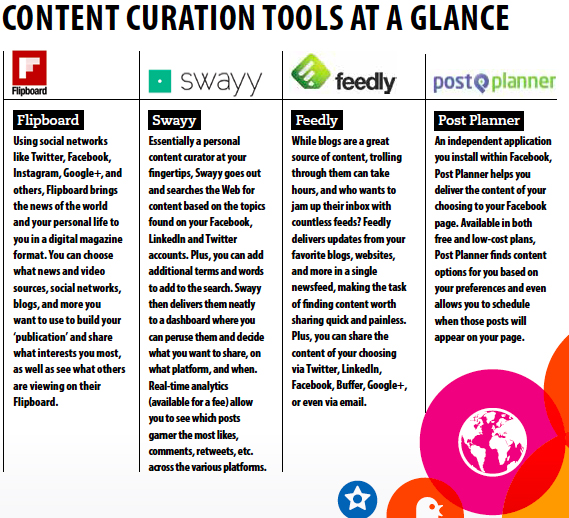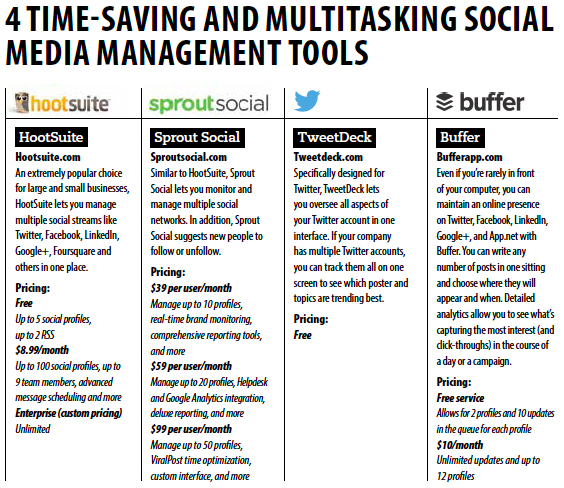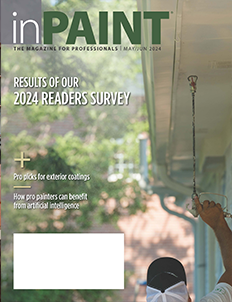Making the Content Connection
 Above all else, building an online presence takes two things: content and commitment. If you find those two words intimidating, take heart. There are tons of useful—and often free—tools available to help you on both fronts. Let’s start with content.
Above all else, building an online presence takes two things: content and commitment. If you find those two words intimidating, take heart. There are tons of useful—and often free—tools available to help you on both fronts. Let’s start with content.
CONTENT IS KING
First and foremost, social media is social. There has to be a give and take between participants and, if you want people to keep paying attention, you always have to have something new to say.
Thanks to content tools like Post Planner, Swayy, Feedly, Flipboard and countless others, instead of you having to go out and look for content on the Web, figuring out what to say is easy. In fact, the content you want actually comes to you.
Content-curation tools allow you to set the parameters for what topics you want to hear about, from what sources, and even how frequently you want updates. Depending upon the tool, the info is either delivered to your inbox or available on your dashboard on a tool’s site. All you have to do is review and decide what you want to share and where.
Not all content-curation tools work for every social media network, and each has its own strengths. It’s up to you to decide which works best with your social media strategy and which interface you find easiest to manage.
OVERCOMING THE FEAR OF COMMITMENT
One of the most common reasons small businesses don’t have a social media strategy is the fear of commitment; specifically, fear of not being able to commit the needed time, resources, and energy to make a strategy successful.
But in reality, implementing a social media strategy today doesn’t require quite the commitment you might think. That’s in large part due to a variety of social media management tools specifically designed for business.
Social media management tools help you identify and grow your audience across different networks (Facebook, Twitter, Foursquare, etc.) by helping you distribute targeted messages to the right audience at the right time, and tracking how well those messages are received.
SAY WHEN
To borrow (and bend nearly to the point of breaking) a classic line, “if a post hits Facebook/ Twitter/LinkedIn when no one’s online, does it make a sound?”
While it’s true that posts don’t fade away like sound waves, they do lose impact if they don’t hit the wires in a timely manner. And by ‘timely’ we mean when your fans, followers, and peers are most likely to be engaged online.
So how exactly do you figure out when folks are most likely to be on one platform or another? And how do you schedule your day so that you can release your latest gems to those specific platforms at those specific moments?
In short, you don’t. You let your social media management tool do it.
Using the scheduler feature common to most tools, you can determine what will appear on which networks and, specifically, when. So say you’re going to run a month-long promotion; in one sitting you can write all your posts, tweets and notifications, and schedule them to appear in the four weeks that follow. That saves you a tremendous amount of time in execution, and ensures that a typical workday emergency doesn’t prevent you from getting your message out when you want.
To help you determine exactly when those messages should go out, any social media management tool worth its salt includes some sort of analytics feature.
Analytics reports let you see what kind of content your audience is clicking on and when they’re doing it. That type of insight allows you to time your own messages to take advantage of your audience’s viewing habits and peak interest days, hours, or even minutes.
Plus, you can then see how popular your own posts were and make adjustments to your schedule to take advantage of shifts or trends in audience engagement.
KEEPING THE CONVERSATION GOING
While content curation and social media management tools can save you untold hours and effort in getting an online conversation going, it’s up to you to keep it going. That is, when fans or followers or prospective customers respond to a post, it’s up to you to respond back. Responding in a timely manner builds your credibility and makes you appear responsive and accessible.
Whether you’re responding to a query or to a complaint, it’s important do it in a timely and civil manner. Responses need not be lengthy or detailed but they do need to happen, lest you appear rude to the poster and everyone else who is watching.
A WORD OF CAUTION ON COMPLAINTS
While complaints are the last thing any business wants to hear, in the world of social media, complaints are what need to be dealt with first.
According to a study by Edison Research, 42% of consumers complaining in social media expect a 60-minute response time. And 57% expect the same response time at night and on weekends as during normal business hours.
Before you panic, recognize that your first response does not have to be your final response (and probably shouldn’t be). As a first step, you want to simply publicly acknowledge that the complaint has been heard and that you are looking into the matter and/or need more information in order to do so—then take the matter offline to get into the details. This demonstrates to the complainer that you’re willing to engage with them further and, just as importantly, demonstrates to others that customer satisfaction matters to you.
Social media is not the place to get into a ‘he-said, you-said’ kind of engagement with a dissatisfied
customer. By keeping your responses respectful and professional, you have a much better chance of changing someone’s opinion of you. Doubtful that could happen? A survey by Bazaarvoice found that seven out of 10 respondents said their opinion of a business changed after a business responded to a negative review.
You always want to make time to acknowledge any and all positive feedback you receive. Consumers trust online reviews—73% of consumers say positive customer reviews make them trust a business more, according to a survey by BrightLocal. Receiving positive feedback with a thank you or a few details on the project and scope of the work is a great way to let someone else blow your horn and build consumer confidence in your services.
To Curate Or Create
While there’s certainly tons of free content out there to consider and use, you should avoid relying too heavily upon it for your social media presence. Yes, curated content offers a huge time-savings, but original content offers these important bonuses:
• it establishes YOU, and not a third party, as an authority
• the information and value you offer is truly unique (i.e., your competitors aren’t sharing the same posts)
• it can be tailored specifically to your target audience
• it serves as an extension of your brand voice and message
• it can address specific conditions or events in your demographic area
• it can be optimized to give your business better search engine rankings
• it creates and/or strengthens the connection to your audience






